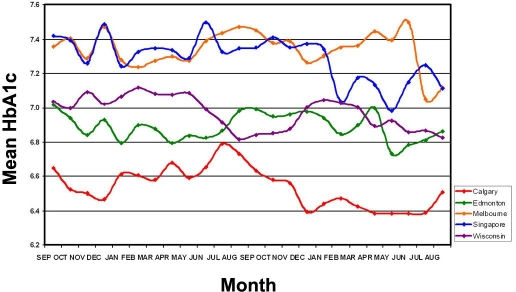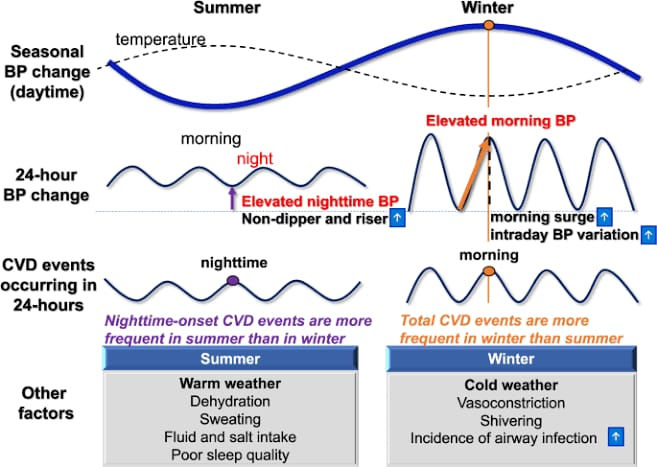Interesting statistical finding of the effect of seasons on various chronic conditions like Diabetes mellitus, hypertension, etc., points toward a trend, forcing clinicians to integrate cultural practices while designing therapy (drug-diet-lifestyle) protocols.
A. Lets us see what a research talks about Diabetes mellitus
Hemoglobin A1c is higher in cooler months and lower in the warmer months in both hemispheres(Article by Trefor Higgins, M.S., Sharon Saw, Ph.D., [...], and David Tran, B.Sc. published in Journal of Diabetes Science and Technology in July 2009 - https://www.ncbi.nlm.nih.gov/pmc/articles/PMC2769947/#!po=15.2174)

Diving deeper into the data published in this report reveals the following:
1. Keeping all other parameters constant, there is a variation seasonally across all population (both the northern & southern hemispheres)
2. Lets take a southern hemispheric region, Melbourne in Australia. The peak HbA1c values are seen around June-July, the winter months in Melbourne. The lower mean HbA1c levels begin in December and are present around February, corresponding to the summer in that region.
2. Lets take a northern hemispheric region, Wisconsin in the US. The peak HbA1c values are seen to start dipping in May, the summer months, while the highest mean HbA1c levels begin in December and are present around February, corresponding to the winter in that region.
CONCLUSION:
Hemoglobin A1c is higher in cooler months and lower in the warmer months in both hemispheres.
Recall:
Madhumeha in Ayurved is the condition described that is shown to have the equivalence to Diabetes mellitus. This condition is supposed to be Kafaj (of Kafa) origin, which tends to get accumilated & vitiated during the winter-spring (shishir-vasanta) months and pacifies during the summers (greeshma).
Rutucharya - the global all-inclusive Preventive Health recipe, is thus the key to stave off from harmful effects of the chronicity as well as the presence of diabetes in any person. The Rutucharya-suggested lifestyle changes & diet address the metabolism to work on pacifying the vitiated doshas, in this case Kafa, to not have any increase in the symptoms/parameters of the disease.
B. Lets discuss Hypertension
Refer the data in the chart below:

Blood pressure (BP) exhibits seasonal variation as below:
a. Elevation of daytime BP in winter
b. Elevation of nighttime BP in summer
c. Increased morning BP surge in winter
d. Increased intraday BP variation in winter (sheeta-guna aggravated Vata)
e. Total CVD (cardiovascular disease) events more frequent in winter (Kafa-Vata mediated blockage & vasoconstriction)
f. CVD events more seen in the morning in winter
Seasonal variation in blood pressure: current evidence and recommendations for hypertension management by Keisuke Narita, Satoshi Hoshide & Kazuomi Kario published in September 3021 in Nature
Recall:
Hypertension is an output attributable to a Kafa-Vata generated avarodhajanya pathogenesis.
Rutucharya - The Rutucharya-suggested lifestyle changes & diet address the metabolism to work on pacifying the vitiated doshas, in this case Kafa-Vata, to not increase the propensity for a CVD event/death due to the same.
Preventive physiological dosha shodhana during specific months via Panchakarma is best to avoid any disease (Vaman in Vasant rutu, Virechan in Sharad rutu & Basti in Varsha rutu)
Also, the golden rule of not allowing Vata to vitiate acutely (chronically as well) and cause a shutdown-type syndrome like a cardiac arrest due to Valsalva in a cardiovascularly compromised person, is the best lifestyle tip to avoid any catastrophe.

Comments